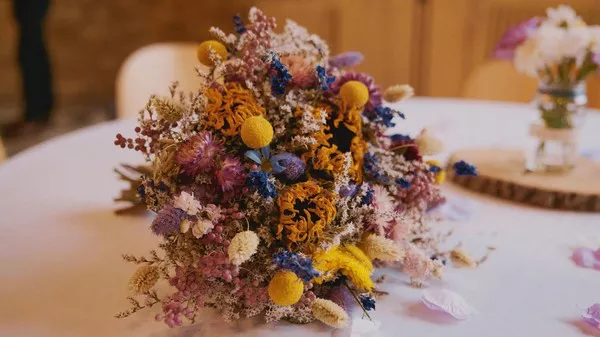Drying flower buds is a wonderful way to capture the essence of nature’s beauty and extend the enjoyment of your favorite blooms. Whether you want to preserve sentimental flowers from a special occasion or create unique crafts and home decorations, learning how to dry flower buds properly is essential. In this comprehensive guide, we will explore different methods for drying flower buds, essential tips for success, and how to select the right flowers, the best time to harvest, creative uses for dried flowers, and storage techniques to maintain their vibrancy.
1. Selecting the Right Flowers for Drying
Resilient Flowers: Some flower varieties are better suited for drying due to their sturdy petals and ability to retain their color and shape. Examples of resilient flowers include roses, lavender, strawflowers, and statice.
Avoiding Delicate Flowers: Delicate flowers with thin petals or high moisture content may not dry well and could lose their color during the drying process. Flowers like pansies and violets are best enjoyed fresh and not recommended for drying.
2. The Best Time to Harvest Flower Buds
Early Morning: Harvest flower buds early in the morning when the plants’ water content is at its highest, ensuring the best chance of preserving the blooms’ vibrancy.
Partially Open Buds: For optimal results, choose flower buds that are partially open but not fully bloomed. This stage strikes a balance between freshness and maturity.
Avoid Overmature Buds: Overmature flower buds may not dry as well and may already be prone to wilting or dropping petals.
3. Methods for Drying Flower Buds
Air Drying: Air drying is one of the simplest and most popular methods for drying flower buds. Gather the flower buds in small bunches and hang them upside down in a cool, dark, and well-ventilated space. Allow them to dry naturally for several weeks.
Silica Gel: Silica gel is a desiccant that efficiently dries flowers quickly while preserving their shape and color. Place the flower buds in a container with silica gel and cover them entirely. Seal the container and allow the flowers to dry for a few days.
Pressing: Pressing flower buds is an excellent method for preserving their delicate appearance. Place the flower buds between sheets of absorbent paper and press them with weight for several weeks until they are fully dried.
Microwave Drying: Microwave drying is a quick method that involves placing flower buds between layers of paper towels and microwaving them in short intervals until dry.
4. Essential Tips for Successful Flower Drying
Avoiding Mold: Ensure that the flowers are completely dry before storing them to prevent mold growth. If you notice any signs of mold during the drying process, remove affected buds immediately.
Handling with Care: Gently handle the flower buds during the drying process to preserve their natural shape and avoid breakage.
Color Retention: Keep the flower buds away from direct sunlight during the drying process to maintain their color vibrancy.
Pest Prevention: Protect drying flower buds from pests by storing them in a clean and dry environment.
5. Creative Uses for Dried Flower Buds
Home Décor: Incorporate dried flower buds into floral arrangements, wreaths, and wall art to add a touch of natural beauty to your home.
Craft Projects: Create unique crafts such as greeting cards, bookmarks, and pressed flower art using dried flower buds.
Potpourri and Sachets: Mix dried flower buds with aromatic herbs and spices to create delightful potpourri or scented sachets for your drawers and closets.
Wedding Keepsakes: Preserve flowers from special occasions like weddings by drying and incorporating them into keepsake boxes or shadow boxes.
6. Storing Dried Flower Buds
Containers: Store dried flower buds in airtight containers to protect them from dust and humidity.
Cool, Dark Place: Keep the containers of dried flower buds in a cool, dark place away from direct sunlight to prevent color fading.
Labeling: Label the containers with the type of flowers and the date of drying to keep track of your collection.
7. Reviving Dried Flowers
Misting: If dried flower buds become too brittle, gently mist them with water to restore some flexibility.
Glycerin Soak: For certain flowers, soaking them in a mixture of glycerin and water can bring back some moisture and flexibility.
8. Eco-Friendly Drying Techniques
Air Drying with Recycled Materials: Use eco-friendly materials, such as recycled paper or natural fibers, for air drying flower buds.
Solar Drying: Take advantage of the sun’s natural heat and energy to dry flower buds, reducing the need for artificial drying methods.
Conclusion
Drying flower buds is a rewarding and enjoyable process that allows you to capture the beauty of blooms in a sustainable way. By selecting the right flowers, harvesting at the appropriate time, and using various drying methods, you can preserve the essence of nature’s splendor for an extended period. Whether you create stunning floral arrangements, crafts, or potpourri, dried flower buds add a touch of elegance and natural charm to your home. By following the essential tips for successful drying and proper storage, you can maintain the vibrancy of your dried flowers for years to come, reminding you of the fleeting beauty of nature’s gift.


